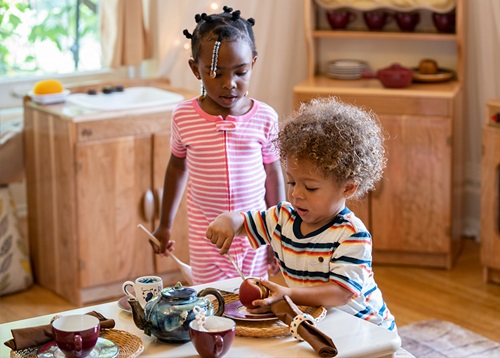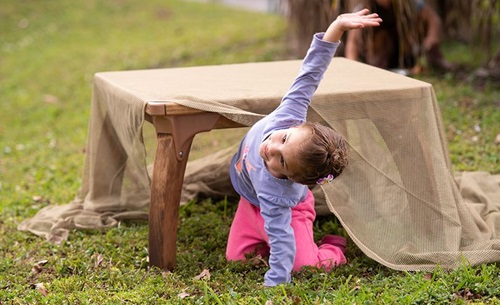What Makes a Good Children's Book?
| October 2005Reading stories is an essential part of early learning, but how is a teacher to choose the right books? Who would have thought that saying goodnight to the moon, to mush, and to nobody, would make Goodnight Moon a timeless bestseller and just the right choice for a young child? Selecting good books is more important than ever because there is so much competition for the quality time you spend with the children in your care. Every minute spent reading a mediocre book is time taken away from reading a good one. So, how does one know what makes a good children’s book? What follows are some guidelines to keep in mind at the library or bookstore.
- Setting: Is it familiar, clear, and authentic? Most young children have never planted vegetables before, but city kids and country kids alike identify with the setting in The Carrot Seed because they can see the determined little boy in themselves.
- Character Development: Do the characters grow, change, and touch our hearts? Are they consistent, believable and whole, as opposed to flat and one-dimensional? Children relate to both the monkeys and the peddler in Caps for Sale. The monkeys have fun taking the peddler’s caps, and the peddler becomes frustrated with the monkey business.
- Plot: Is there tension? Is there a goal? Corduroy wants a home and the Three Billy Goats need to cross the bridge. It is often through plot-driven obstacles like these that good stories develop.
- Theme: Is there a central theme that holds it together? Will the reader become involved in the story or sit passively while being lectured to? There is a wide variety of books published today, but children are still attracted to books with a strong core and universal themes such as good vs. evil, hard work will be rewarded, or cleverness is more important than power.
- Language: Children’s books are difficult to write because they must convey an entire story using very few words. Does the language show respect for the reader? Children love the security of predictable books with rhythm and repetition. The language can be simple as in Brown Bear, Brown Bear, What Do You See? or more complex as in Madeline.
- Art: Are the illustrations bold and in good taste, or overly detailed and busy? More is not better. Does your eye know where to go when you first look at the page? Color does not automatically equal quality and beautiful illustrations do not automatically mean a good story. Make Way for Ducklings, Millions of Cats, and The Story of Ferdinand have been favorites for decades yet they all have two color illustrations, black and white.
- Cover-to-Cover: Like a piece of art, a good children’s book is greater than the sum of its parts. It is honest, has a sense of wonder, and shows respect for the young child. The text and illustrations are integrated to raise the quality of the book. Goodnight Moon and More More More, Said the Baby are two examples that have that sense of wonder and respect that is hard to quantify.
Tips by age group: In general, the younger the child, the more the teacher is in charge of choosing books. What a teacher chooses for a young child is “required” reading so it should be the best of the best. Why waste time reading something mediocre to an infant or preschooler? As a child gets older, the sense of freedom and confidence she gains from choosing her own books at school or the library is enormous and valuable. A third grader who is hooked on a book series, even if the series is not particularly literary, will only benefit and be encouraged to read more more more.
Infant/Toddler
- Safe, non-toxic, and sturdy board books. Introduce to hardcovers.
- Rhyme, rhythm, Mother Goose, song, chant books, “pointing” and identification books.
- Bold, simple illustrations that are not busy or messy. One Mother Goose rhyme per page is more inviting than a busy spread that is chock-full.
- Reading aloud is relationship based and often initiated by the adult. Frequently a book is not read cover-to-cover; there is a lot of back-and-forth of page turning and pointing. When a young child is eating finger food in the high chair, this is a good time to read a whole book aloud, introducing and reinforcing the beginning-to-end sequence.
Preschoolers
- Illustrated hardcovers and paperbacks.
- Wide variety of books – Mother Goose, poetry, ABC, stories, traditional tales, informational books.
- Bold illustrations, not overly detailed. Messy or abstract art is not appropriate.
- Reading aloud to preschool children is relationship based. The books need to be kept on a low shelf, accessible to children so they can also hold and read the books on their own.
Kindergarten
- Hardcovers and paperbacks.
- Fiction, poetry, traditional tales, fantasy, historical fiction, biography, nonfiction, series.
- Anything in good taste is appropriate. Kindergarten children need freedom to choose books on their own without judgment from the teacher.
- The listening vocabulary at this age is much larger than the reading vocabulary so it is important to continually read aloud good, more complex books.
Selecting good books is one of the best ways to nurture young children. Reading aloud shows affection, caring and a desire to connect and have fun. It is a teacher’s chance to be completely present and attuned to each child. Selecting books mindfully gives the message that only the best will do, emphasizing the dignity of childhood.
The Basic Library from The Book Vine contains essential books for every center. See the list of titles below. You can order it from www.BookVine.com or call 800-772-4220.
| Big Red Barn | Brown |
| Blueberries for Sal | McCloskey |
| Brown Bear, Brown Bear, What Do You See? | Martin |
| Caps for Sale | Slobodkina |
| The Carrot Seed | Krauss |
| Chicka Chicka Boom Boom | Martin |
| Corduroy | Freeman |
| Curious George | Rey |
| Freight Train | Crews |
| The Gingerbread Boy | Galdone |
| Goodnight Moon | Brown |
| Harold and the Purple Crayon | Johnson |
| If You Give a Mouse a Cookie | Numeroff |
| Make Way for Ducklings | McCloskey |
| Mike Mulligan and His Steam Shovel | Burton |
| Millions of Cats | Gag |
| More More More, Said the Baby | Williams |
| My Very First Mother Goose | Opie |
| The Runaway Bunny | Brown |
| The Snowy Day | Keats |
| The Story of Ferdinand | Leaf |
| Ten, Nine, Eight | Bang |
| The Three Billy Goats Gruff | Galdone |
| The Very Hungry Caterpillar | Carle |
| Where the Wild Things Are | Sendak |
Printed with permission, 2005, The Book Vine. A version of this article previously appeared in Scholastic Parent and Child Magazine.






